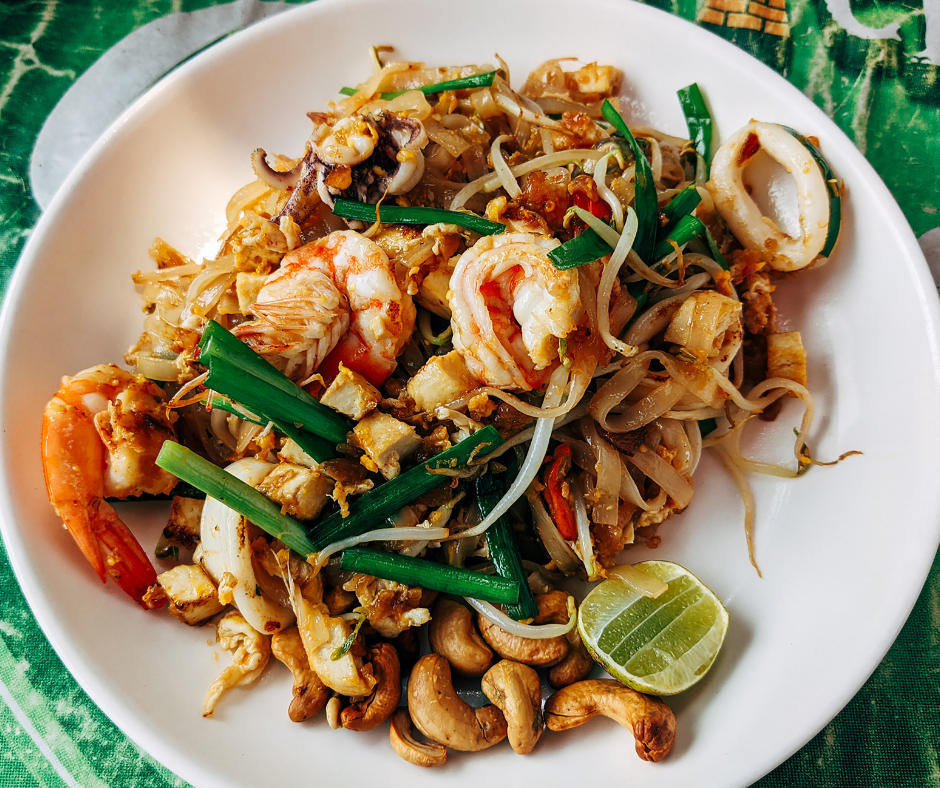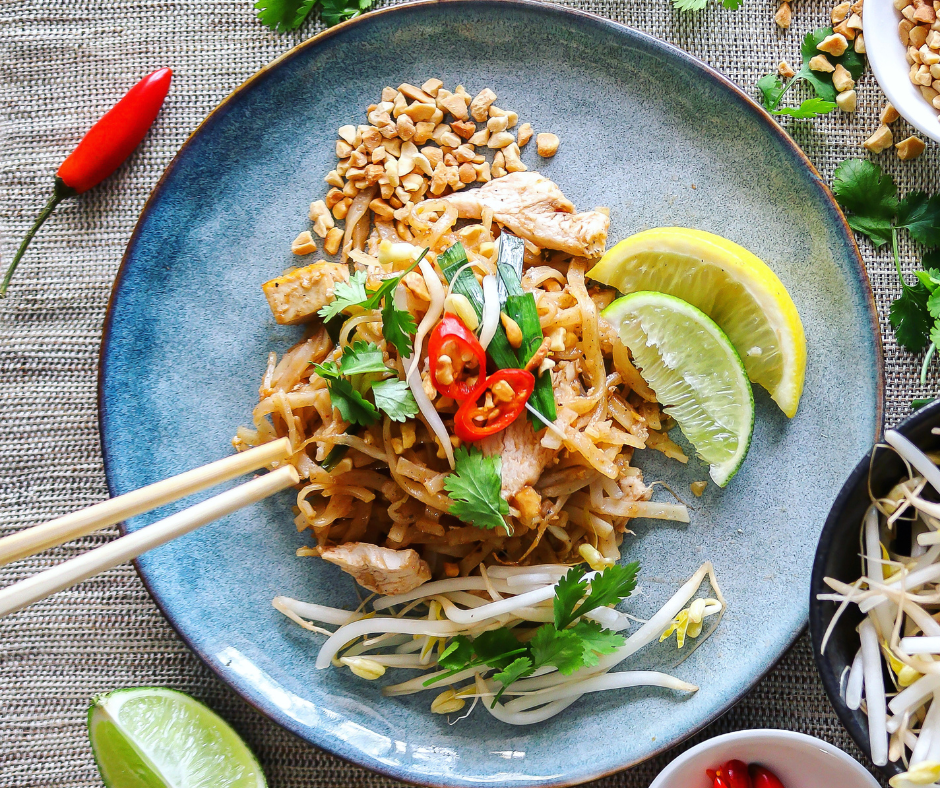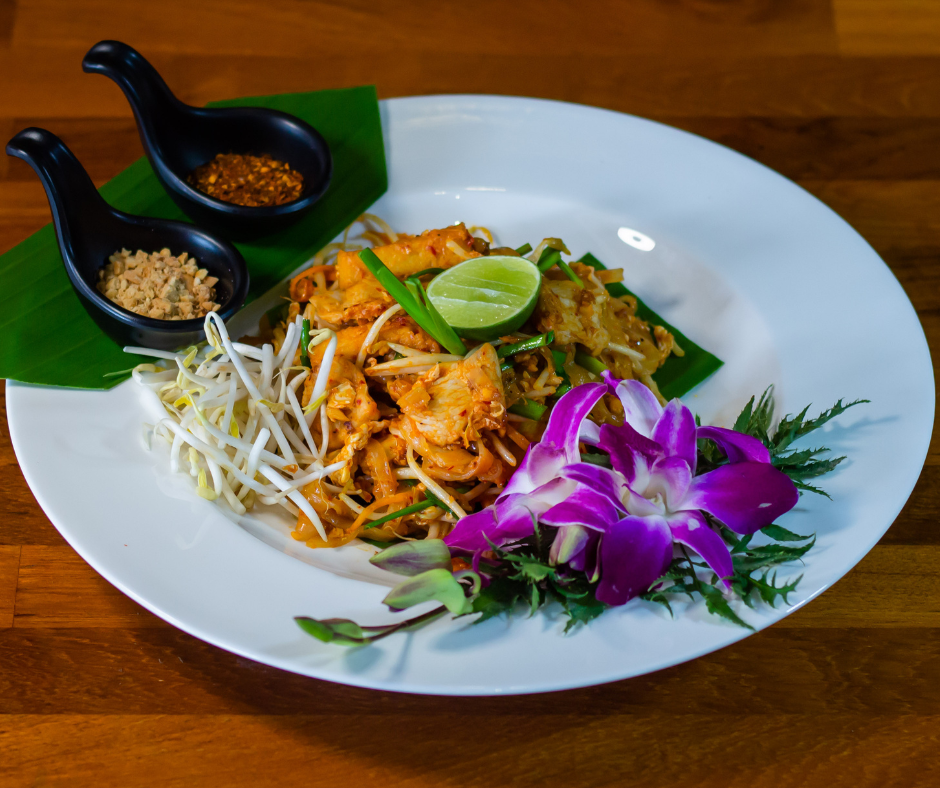Introduction
Pad Thai is a beloved dish that has gained popularity worldwide. But as dietary restrictions and allergies become more prevalent, many wonder, Does Pad Thai Have Peanuts? In this article, we will deconstruct the ingredients of Pad Thai and explore whether peanuts are a common component.
Explanation Of Pad Thai As A Popular Thai Dish
Pad Thai is a flavorful dish that originated in Thailand and has become synonymous with Thai cuisine. It typically consists of stir-fried rice noodles, eggs, tofu or shrimp, bean sprouts, and a medley of vegetables. The dish is often garnished with lime wedges, chopped peanuts, and cilantro. The combination of sweet, sour, and savory flavors makes Pad Thai a crowd-pleaser.
Brief History Of Pad Thai And Its Authenticity
Pad Thai has a fascinating history that dates back to the 1940s. During World War II, Thailand faced a rice shortage due to the Japanese occupation. The Thai government launched a campaign to promote rice noodles as a substitution for rice, and that’s how Pad Thai was born. It was initially seen as a patriotic dish symbolizing self-sufficiency and Thai identity.
Authentic Pad Thai does include peanuts as a key ingredient. The chopped peanuts add a delightful crunch and nutty flavor to the dish. However, it’s important to note that not all versions of Pad Thai include peanuts. Some variations may omit peanuts due to personal preferences or allergies.
While peanuts are a common ingredient in traditional Pad Thai, requesting a peanut-free version at certain restaurants is possible. Chefs can accommodate dietary restrictions and replace the peanuts with alternative ingredients or exclude them.
It’s also worth mentioning that peanuts are not the only nutty element in Pad Thai. Some recipes may use other nuts like cashews or almonds instead of peanuts or as an additional garnish. Therefore, it’s necessary to double-check with the chef or server to ensure that the dish is suitable for those with peanut allergies.
In summary, Pad Thai is a popular dish that typically includes peanuts as a garnish. However, being mindful of individual dietary restrictions and preferences is important. If you have a peanut allergy or prefer not to have peanuts in your Pad Thai, requesting a modification when dining out is possible. The versatility of Pad Thai allows for customization to suit different tastes and dietary requirements.
The Key Ingredients In Pad Thai
Rice Noodles And Their Significance In Pad Thai
One of the crucial components of Pad Thai is rice noodles. These flat, thin noodles are the dish’s foundation and provide a satisfying chewy texture. Rice noodles are made from rice flour and water, making them gluten-free and suitable for individuals with dietary restrictions. They are soaked in water to soften them before being stir-fried with other ingredients.
Protein Options
Pad Thai typically includes a protein option to add flavor and substance to the dish. The most common protein options in Pad Thai are shrimp, chicken, or tofu. Shrimp is a popular choice that lends a seafood essence to the noodles. Chicken provides a savory and tender bite, while tofu offers a vegetarian or vegan alternative. The choice of protein can vary depending on personal preference and dietary restrictions.
Pad Thai Sauce
The signature flavor of Pad Thai comes from its sauce. The sauce combines sweet, sour, and savory flavors harmoniously. It is typically made from tamarind paste, fish sauce, palm sugar, and lime juice. These ingredients create a delicate balance of tanginess, sweetness, and umami. The sauce is added to the stir-fried noodles and proteins, coating them with delicious flavors.
Vegetables And Garnishes
Pad Thai is often packed with vibrant vegetables that add crunch and freshness. Common vegetables in Pad Thai include bean sprouts, green onions, carrots, and cilantro. These vegetables provide a pop of color and contribute to the overall taste and texture. Pad Thai is often garnished with crushed peanuts, a squeeze of lime juice, and a sprinkle of chili flakes for added complexity and garnish.
Does Pad Thai Have Peanuts?
So, Does Pad Thai Have Peanuts? While peanuts are one of the popular garnishes in Pad Thai, they are not an essential ingredient in the dish itself. However, many traditional recipes include crushed peanuts as a topping. Peanuts add a delightful crunch, nuttiness, and richness to the dish. They can be omitted if you have allergies or personal preferences, but they are often a beloved addition to Pad Thai.
In conclusion, Pad Thai is a flavorful and versatile dish with various ingredients contributing to its taste and texture. Rice noodles form the base, protein options like shrimp, chicken, or tofu provide substance, and the sauce ties everything together with its distinctive flavors. Vegetables and garnishes add freshness and complexity, while crushed peanuts serve as a popular topping. Whether you enjoy Pad Thai with or without peanuts, it remains a delicious and beloved dish many worldwide enjoy.
The Flavor Balance Of Pad Thai
Exploring The Combination Of Salty, Sour, Sweet, And Spicy Flavors
Pad Thai, a popular Thai dish, is renowned for its complex flavor profile that combines salty, sour, sweet, and spicy tastes. These contrasting flavors harmonize harmoniously to create a delicious and satisfying culinary experience.
The salty element is usually derived from ingredients such as fish sauce or soy sauce. This savory component adds depth and richness to the dish, enhancing the overall flavor. The sourness comes from adding tamarind paste or lime juice, providing a tangy and refreshing note that balances out the richness of the other ingredients.
To achieve the perfect balance, Pad Thai incorporates a touch of sweetness. This is typically achieved through palm or brown sugar, adding a subtle sweetness that complements the other flavors without overpowering them. Finally, the dish is infused with a hint of spiciness, achieved by using chili peppers or chili sauce to add a kick to the overall taste.
The Role Of Bean Sprouts And Peanuts In Adding Texture
Bean sprouts and peanuts are essential in adding texture to Pad Thai. Bean sprouts are crisp and crunchy, providing a refreshing contrast to the soft noodles and other ingredients. They also contribute a fresh and light element, enhancing the overall mouthfeel of the dish.
Peanuts, however, add a delightful crunch and nuttiness to the dish. They provide a rich and creamy texture that complements the other ingredients. Peanuts also add depth of flavor, enhancing the overall taste experience.
It is important to note that while peanuts are a traditional ingredient in Pad Thai, some recipe variations may omit them due to personal preferences or dietary restrictions. If you have concerns about allergies or do not enjoy peanuts, feel free to omit them or substitute them with an alternative ingredient that suits your taste.
In conclusion, the flavor balance of Pad Thai is achieved through the combination of salty, sour, sweet, and spicy elements. Adding bean sprouts and peanuts adds texture, enhancing the overall eating experience. Whether you are a fan of peanuts or not, Pad Thai can still be enjoyed and customized to suit your preferences. So grab your chopsticks and indulge in this delightful Thai delicacy!
Customizing Pad Thai
When it comes to enjoying a delicious plate of Pad Thai, customization is key. Not only does it allow you to tailor the dish to your taste preferences, but it also gives you the flexibility to accommodate dietary restrictions or allergies. This article will explore the various options for customizing Pad Thai to suit your needs.
Vegetable Options And Their Addition To Pad Thai
One great thing about Pad Thai is its versatility in vegetables. While traditional Pad Thai typically includes ingredients like bean sprouts, green onions, and carrots, you can experiment with various vegetables to add more flavor and nutritional value.
Here are some vegetable options you can consider adding to your Pad Thai:
- Bell Peppers: The vibrant colors and crisp texture of bell peppers can enhance the visual appeal of your Pad Thai. You can choose between red, green, or yellow bell peppers based on your preference.
- Mushrooms: Mushrooms add an earthy flavor and a meaty texture to the dish. Shiitake, cremini, or oyster mushrooms work well with Pad Thai. Before adding them to your noodles, make sure to sauté them until they are tender and slightly caramelized.
- Snow Peas: These crunchy and sweet peas can provide a refreshing contrast to the other ingredients in your Pad Thai. Their bright green color adds visual appeal as well.
Remember to experiment with different vegetable combinations to find the ones that suit your taste buds best. Don’t be afraid to get creative and add your favorite vegetables to make your Pad Thai more enjoyable.
Substitutes For Fish Sauce And Alternatives For Peanut Allergies
If you have dietary restrictions or allergies, options are available to make Pad Thai suitable for your needs. Two common concerns regarding Pad Thai are fish sauce and peanuts. Here are some substitutes and alternatives you can use:
- Fish Sauce Substitute: If you prefer a vegetarian or vegan option, you can replace fish sauce with soy sauce and tamarind paste. This will give your Pad Thai a similar umami flavor.
- Allergy-friendly Peanut Substitutes: Peanut allergies can be challenging when enjoying Pad Thai. However, you can substitute peanuts with nuts or seeds like cashews, almonds, or sunflower seeds. These alternatives will still provide a similar crunch and texture to your dish.
It’s important to note that if you have severe allergies, you should carefully read the ingredient labels or consult with a healthcare professional before trying any substitutes.
Customizing Pad Thai lets you make your dish while accommodating your dietary needs. Whether adding extra vegetables or substituting, these adjustments can help you enjoy a delicious plate of Pad Thai without compromising your preferences or health requirements. So go ahead, get creative, and customize your Pad Thai to suit your taste buds. Happy cooking!
FAQ: Does Pad Thai Have Peanuts? Deconstructing the Ingredients of Pad Thai
Q: Is Pad Thai typically made with peanuts?
A: Traditionally, Pad Thai can include peanuts as one of its ingredients. However, it is important to note that not all Pad Thai recipes contain peanuts.
Q: What are the common allergens in Pad Thai?
A: Pad Thai can potentially contain several allergens. Some of the common allergens found in Pad Thai include shrimp, fish sauce, peanuts (or sometimes cashews), eggs, tofu (soy), and soy sauce (which may contain wheat). Additionally, if fresh noodles are used instead of dried rice noodles, there may also be starch present.
Q: Can Pad Thai be made without peanuts?
A: Yes, Pad Thai can be made without peanuts. For those with peanut allergies, crushed sunflower seeds can be used as a substitute for peanuts to add a similar crunch and flavor.
Q: Are there any other potential allergens in Pad Thai?
A: Apart from the top 8 allergens, there is a slight chance of cross-reactivity due to the inclusion of tamarind in some traditional Pad Thai recipes. Tamarind is a legume similar to peanuts, beans, and soy. However, there is no scientific or peer-reviewed evidence confirming this cross-reactivity. If you have any concerns about tamarind, it is recommended to consult with your allergist before adding or omitting it from your diet.
Q: How can Pad Thai be adapted for individuals with food allergies while staying true to its authentic flavors?
A: Cooking for individuals with food allergies often requires substitutions or modifications to the original recipe. However, it is important to maintain the essence of Pad Thai while accommodating allergen restrictions. For example, crushed sunflower seeds can be used as a substitute for peanuts to maintain the desired crunch and flavor. It is advised to explore alternative ingredients with similar characteristics to the allergens being replaced.
Conclusion
Now you should know the answer to ‘Does Pad Thai Have Peanuts?’. After analyzing the ingredients of Pad Thai, it is clear that peanuts are a key component in traditional recipes. However, it is important to note that including peanuts may vary based on personal preferences, dietary restrictions, and regional variations.
Final Thoughts On The Presence Of Peanuts In Pad Thai
While peanuts are commonly used in Pad Thai, it is not impossible to find variations of this dish that do not contain peanuts. Some chefs and restaurants may omit peanuts due to allergies or personal taste preferences. Therefore, if you have concerns about peanuts, it is always a good idea to ask the chef or server about the ingredients in the Pad Thai before ordering.
If you have a peanut allergy, it is important to be cautious when consuming Pad Thai from restaurants or street vendors. Cross-contamination is always a risk, so it is advisable to inform the restaurant staff about your allergy to ensure the safety of your meal.
Appreciating The Diverse Flavors And Ingredients In This Iconic Dish
Pad Thai is a versatile dish that can be customized with various ingredients to suit individual tastes and dietary needs. Whether it includes peanuts, Pad Thai remains a delicious and popular dish showcasing Thai cuisine’s vibrant flavors.
By deconstructing the ingredients of Pad Thai, we can gain a deeper understanding and appreciation for the complexity of this iconic dish. From the tangy tamarind sauce to the generous garnish of peanuts, each ingredient contributes to the overall flavor profile and texture of Pad Thai.
Whether you prefer your Pad Thai with or without peanuts, exploring the different variations and experimenting with various ingredients can be a fun and tasty adventure. So go ahead, indulge in the culinary delights of Pad Thai, and savor the rich flavors that make this dish so beloved worldwide.
Remember, peanuts in Pad Thai should not deter you from enjoying this delicious dish. With a little awareness and communication, you can still enjoy a mouthwatering plate of Pad Thai that suits your preferences and dietary needs.



